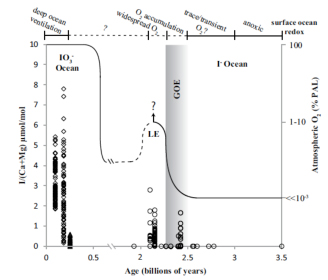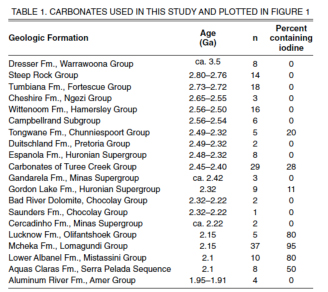2014 Annual Science Report
 Arizona State University
Reporting | SEP 2013 – DEC 2014
Arizona State University
Reporting | SEP 2013 – DEC 2014
Task: 3a: Ancient Records - Geologic
Project Summary
Among the fundamental questions in Earth history is when and where O2 first accumulated in the shallow ocean. These settings could have been ideal local ‘oases’ for initial O2 accumulation and for early eukaryotic life. Iodine geochemistry has emerged as an exciting possibility for exploring such settings characterized by carbonate deposition, but the proxy remains only rudimentarily known because of the lack of validation and calibration in modern shallow carbonate environments. Our work over the past year sought to remedy that situation while simultaneously exploring the proxy’s potential in deep time.
Project Progress
Our efforts over the past year focused on development and application of the iodine paleoproxy. Specific theme: Iodine—A Novel Carbonate Proxy for Constraining Oxygen Levels in the Early Shallow Ocean.
Iodine-to-calcium ratios (I/Ca) in carbonates have promising potential as paleoredox indicators, but concerns about diagenetic overprints have remained poorly studied. As part of our iodine research, we have initiated a systematic exploration of the patterns and pathways of diagenesis. We hope to better understand when and why primary I/Ca signals are preserved and how they can be reset.
As a first step, we analyzed a series of short sediment cores (<0.5 m) and associated pore fluids collected from several adjacent shallow, low-TOC, carbonate platform sites near Little Darby Island, Bahamas. Measurements from the Bahamas sediments include I/Ca; δ13Ccarb; TOC; and pore water SO4-2, H2S, and Ca+2. To complement our study of very early diagenetic effects, we have subsampled the Unda and Clino drill cores—collected in the Bahama Banks in 1990 and now curated by our colleague Peter Swart at the University of Miami. These well-characterized cores provide a unique opportunity to address changes in I/Ca across a range of diagenetic pathways and controls. Phase 2 of this iodine project was analysis of a comprehensive suite of Precambrian samples described briefly below.
Samples were collected from 20 Neoarchean to Paleoproterozoic carbonate sections (focusing on the Lomagundi Carbon Isotope Excursion) and analyzed for I/(Ca+Mg) ratios. The results revealed a clear trend from an absence of carbonate-bound iodine in the Neoarchean to the presence of carbonate-bound iodine following the Great Oxidation Event. This trend indicates an increase in near-surface marine oxygen concentrations associated with the Great Oxidation Event and Paleoproterozoic Lomagundi Carbon Isotope Excursion. Results were published in GEOLOGY (Hardisty et al., 2014).
Additionally, carbonate samples from the exceptionally well preserved ~2.6 Ga Carawine Dolomite in Australia were collected at good stratigraphic resolution (n=60) for iodine measurements as well rare sulfur isotopes in carbonate-associated-sulfate. Also, results from Hardisty et al. (2014) were used to catalyze a funded grant (NASA Astrobiology Early Career Collaboration Award) for UC Riverside graduate student Dalton Hardisty to travel to Syracuse University and Harvard University to collaborate with Professor’s Zunli Lu and David Johnston, respectively (see below).
Finally, building on Hardisty et al. (2014), we collected samples from 16 carbonate formations spanning the Paleoproterozoic to Neoproterozoic for I/(Ca+Mg) analysis to establish a complete record of evolving Precambrian surface ocean oxygen accumulation. The Shuram Carbon Isotope Excursion of the Neoproterozoic was analyzed in detail for I/(Ca+Mg) ratios for 350 samples at high stratigraphic resolution from four individual carbonate sections. Results provide simple and direct evidence that the Shuram Excursion is not diagenetic but rather is a primary feature capturing marine conditions. A manuscript is currently under consideration at Nature.
Sample summary (details above, including analyses):
Modern/near-modern samples:
* Bahamas – long cores: Clino, Unda.
* Bahamas – short cores: Little Darby and Lee Stocking Island.
Precambrian samples: * Carbonates from 40 Precambrian carbonate formations. * Focus on the GOE, the Paleoproterozoic Lomagundi Carbon Isotope Excursion, the Shuram Carbon Isotope Excursion, the Mesoproterozoic, and potential Neoarchean oxygen oases.


Publications
-
Hardisty, D. S., Lu, Z., Planavsky, N. J., Bekker, A., Philippot, P., Zhou, X., & Lyons, T. W. (2014). An iodine record of Paleoproterozoic surface ocean oxygenation. Geology, 42(7), 619–622. doi:10.1130/g35439.1
-
PROJECT INVESTIGATORS:
-
PROJECT MEMBERS:
Timothy Lyons
Project Investigator
-
RELATED OBJECTIVES:
Objective 4.1
Earth's early biosphere.
Objective 4.2
Production of complex life.